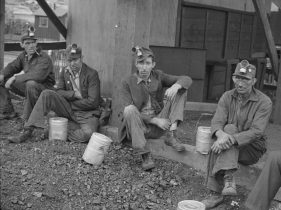There is the possibility of a crisis, and it seems that not even the president knew about it. With no clear resolution in sight, the expiring contract between mine owners and the United Mine Workers might lead to a strike that could halt American coal production.
Negotiations for a renewal of the contract are not off to a promising start; in fact they haven’t started at all. The original start date of March 1 has been moved twice, and negotiations are now estimated to begin on March 14, giving the parties only 17 days before the old contract expires. Many are wondering if that is enough time.
Even though these upcoming contract dealings affect over 500,000 workers, President Franklin D. Roosevelt knew nothing of the situation until a reporter brought it to his attention during a press conference in early February.
The United Mine Workers, represented by John Lewis, are not just looking for another contract, but are also fighting for a $2 per day wage increase. This pay increase is contrary to the provisions laid out in the Little Steel Formula that the War Labor Board has been enforcing since last July. This formula ties wage increases to the cost of living, meaning that no one can receive a raise greater than 15 percent this year.
The 25 percent wage increase that the United Mine Workers are asking for definitely does not fit within those requirements. There is also the issue of the “No Strike” policy that the president and the War Labor Board (WLB) initiated, stating that no worker in a war-related industry has the right to strike.

Striking coal miners’ unions reps meet with the National War Labor Board, January 15, 1943. Photo by Alfred T. Palmer, from Library of Congress.
There has been some confusion over the past month on whether the miners will strike if a contract is not ratified. In February, Lewis declared that the mine workers would endeavor to obtain wage increases “without interruption of production if we are permitted to do so.” However, early this month Lewis announced that the miners will not work as of April 1 if a contract is not in place.
Lewis said that if a strike has to occur in the upcoming months it will not break the WLB’s “No Strike” policy. He argued that this No Strike policy was agreed upon by working groups on the condition that the federal government would set up a board to clarify labor disputes on a judicial basis. He claims that the WLB has not done this.
Although there has been no firm statement about what the White House is going to do, the president has been meeting with James F. Byrnes, head of the Office of Economic Stablization, to discuss strategies. Sources say Roosevelt plans to stand firm on the Little Steel Formula. However, before the war when there was a conflict over pay raises with miners, the deadlock lasted five weeks, during which time no coal was taken from the pits.
This issue is now in the hands of the White House and War Labor Board. Although there is no certainty that they will strike, the United Mine Workers have made their demands clear—they want a $2 per day raise. However, with the war in full force across the globe, the United States does not have the time or resources to go five weeks without coal and a firm stance by the president is not going to get 500,000 workers back into the mines.

Coal miners in Kentucky, 1935 (Photo by Ben Shahn, from Library of Congress).
Sources:
Gilbert, B.W. (1943, Feb. 4) Lewis Opens Struggle to Smash Pay Ceilings. The Washington Post.
Shaplen, J. (1943, Mar. 4) Lewis calls WLB a ‘Packed Court’. New York Times
Stark, L. (1943, Feb. 7) Coal Tie-up is feared unless Washington Acts. New York Times
Sullivan, M. (1943, Feb. 28) John L. Lewis and His Aims. The Washington Post
(1943, Mar. 1) New Move by John L. Lewis Threatens Coal Production of the Nation. Pittsburgh Post- Gazette.
(1943, Feb. 3) Mine Workers Demand 42 Day Boost in Wages. Chicago Daily Tribune.
(1943, Mar. 11) Lewis Flays Little Steal Formula. Pittsburgh Post- Gazette.





